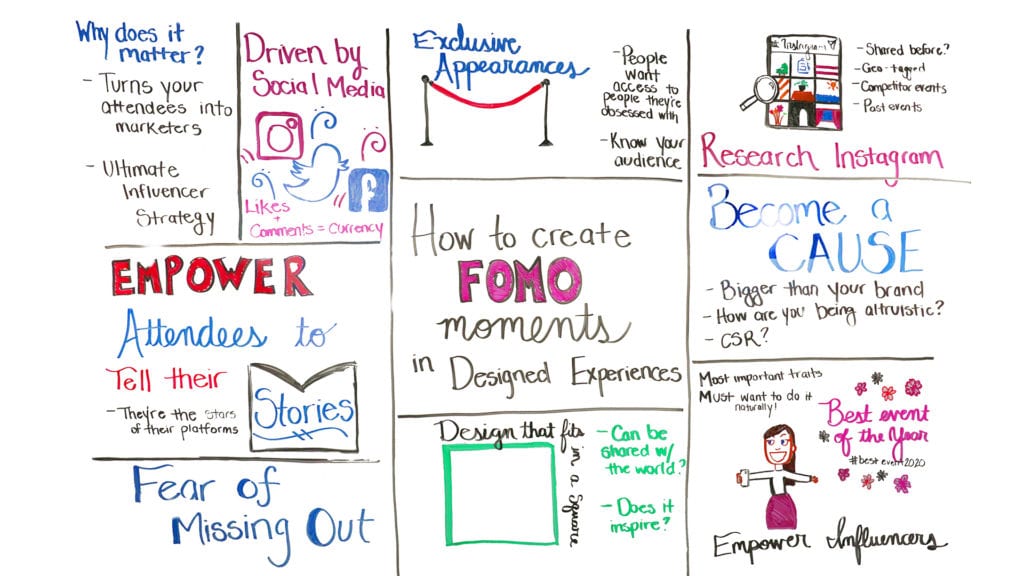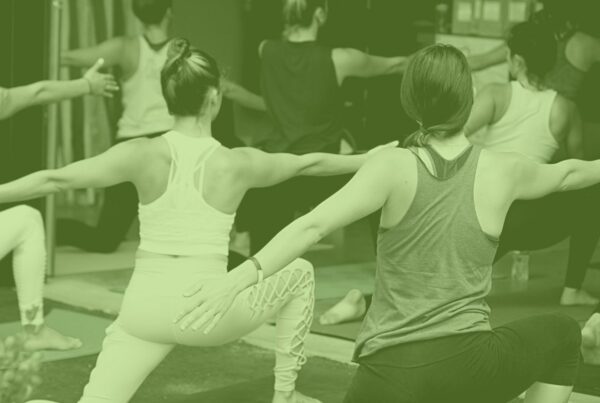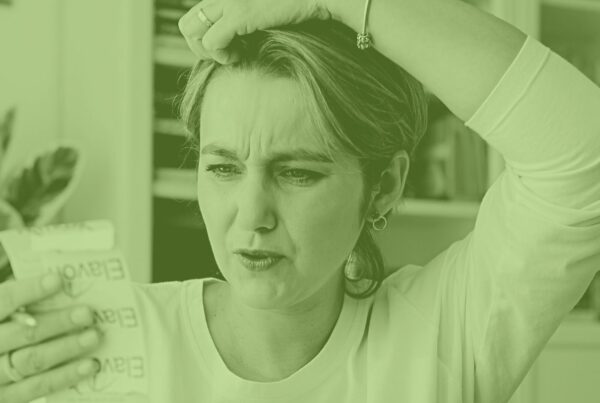Wouldn’t the world be perfect if every person out there felt event FOMO? In particular for the event that you’ve put together? Fear Of Missing Out, or FOMO, is a term that’s been thrown around for a while. Blame it on the Millenials, or blame it on social media. But the truth is, as event planners, we all wish we could snap our fingers and make everyone in our target audience feel it. After all, it’s probably one of the best events out there, right? Or at the very least, we always try to make it so.
And because we’re current and edgy, we want to help you out. So we bring you a brand new edition of Whiteboard Wednesday! Our fantastic host Nick Borelli is ready to tell you all about how to create event FOMO through design experiences. Are you ready to start turning your audience into kick-ass ambassadors? Press play, you won’t want to miss this!
Video Transcription – How to Create Event FOMO Through Design Experiences
Hi, this is Whiteboard Wednesday’s. I am Nick Borelli, and we’re going to be talking to you about event FOMO, which I think most people know is fear of missing out. And how to create those moments within a live event. You do that because I guess the intended goal really of fear of missing out for the live event designer is for attendees to push that feeling onto people who didn’t attend. So, it’s really a strategy that takes intuitive design and human behavioral psychology. And applies it to the next year. So, this isn’t about growing your show this year, this is about transforming your attendees into vocal advocates to their community to this is why this event is something that they should experience themselves.
Event FOMO – How Can I Do It?
So, I just want to kind of set the parameters of what your expectations would be. This is kind of like a not this year thing, it’s the following year, or the next event, or the next month, or what your brand is all about. But it’s kind of making your attendees into your marketing department. And really that’s where you can get huge growth. Imagine if you have 1,000 attendees at your event and each one of them has 1,000 followers. Think of what that would cost in a media buy to get people to see your event and find out about your event.
And even if you did make that really expensive purchase, it wouldn’t nearly be as impactful. Because these are people who are their friends, their family, they believe in them and the testimonials are coming in a little bit more of a real way and an authentic way and a passionate way. But to do that, you have to really get in this mindset. And this is really difficult I think for a lot of people. They’re not going to want to share your message with their friends and family. I know that’s the point, right? The reality is, is that they’re the star. So they’re going to talk about their journey, their mission if they call it that or not. But they’re going to want to tell the story of them. And what you are providing them really is just context and setting.
First Things First…
It’s a really tricky thing to wrap your brain around. Because it’s not about like well here’s all the things why you should attend the event. You, attendee, why don’t you tell your friends and family this message that I’m telling you to tell them. They won’t do that. They pay money, or they’re spending their time to come to your event because it means something to them. And you have to really find out why they’re there, and then design experiences that make them want to tell their story in a louder, more passionate way that also brings you along for the ride. This could only happen then, they’re empowering me to tell this. And they are giving me the tools I need to be able to be the best me.
That kind of mentality you can actually design and find that that is shared just more truly and more honestly. Fear of missing out is a phenomenon that’s existed forever, it’s just built into humanity. Why it’s a buzzword, why you hear about it so frequently is because of social media. Social media has done a lot of things to mankind. One of the things, I mean some of it positive, some of it negative, it’s really just a neutral tool. And it’s more of a mirror really than it is anything else. It’s who we are, but it does, especially in its newest incarnation, over time it may evolve. But right now one of the things it is, it kind of is a viewpoint into people’s lives, but highly curated. It’s not like, “Here’s me paying my taxes.” “Here’s my kid not eating.” It’s really mostly the best moments, and kind of skewed from that perspective.
Give Me All The Love
And the reason for that is likes and comments, the more you get of those things, the more positive affirmations that you get back from the existential things you put out to the world. “Am I really here? Do you really care about me?” When you get this stuff back, what you find is it kind of releases endorphins, it makes you feel good. And subconsciously, or maybe sociopathic people consciously, they put stuff out into the world to get that. And you do that over time and it’s a learned behavior and all of a sudden you curate what you put out to the world because this is how you want to be seen.
So, you want to be seen as this elevated version of yourself, this loftier version, this more successful version. And what it’s done is it’s put the feeling on other people, “Well, I’m not achieving that. I’m not going out to the places that person is. So, I’m less than, so I need to step up my game and keep up with the Jones’s.”
Can I Pay In Experiences?
It was the country club memberships, it was cars, it was all these things in the past. And now really the currency is experiences, and it’s experiences through this lens of positivity. So, we’re not going to fix that today, we’re just going to actually take advantage of that. And instead, give people more of those experiences that they would share in order to point more people to the events that we produce. And that really means, again, empowering your attendees to tell their story so they’re the star. So then finding the things that they love to share, and then giving them those opportunities.
But I Told To Do It This Way!
And I’m going to tell you what doesn’t work as successful is telling people what to do. Having a sign that says, “Stand right here and use this hashtag and join the conversation”. All that stuff is leading people so directly that they don’t really do it enthusiastically or in the same volumes as they would if they think they came up with it themselves. So, you need to be able to design things that take in how people want to share their world. So for instance, if there are certain causes that you know that the people who attend your event are into that are really meaningful for them, create opportunities that they have that they can show off that they’re part of a movement. Or even people that they aspire to be around. You can have these exclusive experiences with keynote speakers if it’s conferences, if it’s celebrities within small niche circles. Give them that.
Event FOMO Isn’t That New
I’ve seen at the RNC and DNC conferences, I mean they had all these selfie booths were essentially the candidates would stand in a certain spot a little bit heightened. And everybody would turn around and take a selfie and that person would be in the shot. That’s an $8 box that they stood on. And yet it was a really impactful design element simply because it took advantage of the rare opportunity to be in the same room as that person.
Cut to 25, 30 years ago, that would have been a line for autographs. But autographs are stuff, and this is sharing experiences through social media. And that’s kind of where people are at in order to prove that they’re living this elevated life. So, when you design, you have to keep in mind that this is all powered by social media, the most visual of which is definitely Instagram. Which makes you think about the design of everything that is big moments and the shareable moments and the stuff that has maybe some messaging behind it. It should fit ideally in a square, in a design part that takes that person and there’s a space for the messaging. Be it the backdrop of a city, be it the archway that has the letters of the association. Whatever it is, that should fit in kind of a square for Instagram.
Create Event FOMO By Sharing
And I know Instagram can be all these other things, and I’m being a little rigid when I say square. But mostly what I’m saying is to make sure that this is designed as such so it fits very easily from photography that can be in a phone. And that selfies or what have you can really be the utility that gets this out into the world. So, that’s something I think is really important. But there’s a flip side of that, you have to actually be inspired by the other squares. You have to spend time, on Instagram specifically, but other platforms as well depending on where your people are. And you need to look at what they’re doing in order to create a design that gets more of what you want.
Pay Attention To The People
So, an example is if you’re at a specific let’s say hotel next year for your event. Look at what people were taking pictures of at that hotel. It doesn’t have to be your event, but other events that take place that was geotagged at that location. What you’ll find is there are probably certain areas that are more photographable than others. There are probably areas that have better lighting, just whatever it is, but you’ll end up finding where most photos are being taken and shared online. And maybe there’s some information about people telling their own stories that are there because there’s a pool. So, people showing off that they’re at this luxurious pool, or there’s an amazing centerpiece in the hotel. Whatever it is, take that information. Because that’s very valuable. And you might be able to skew your design to create maybe an opportunity to include some kind of stakeholder logo, placement, or better yet some integrated messaging that they have that would fit the kind of messaging that people are sharing from that space.
You can do that by looking at, again, there are geotags. But you can also look at competitive events to see okay, is the opportunities that people are sharing at their events that you might be able to co-opt a version of it that fits what your event is about? You just need to pay attention to social media as far as the other event FOMO moments that are taking place either at the same venue, with the same community, and previous events that you had. And you need to look at all that before you design. Because what we’ve never had really in art in general maybe, or design, or creative pursuits, is the ability to give people something creative, and then see how they use that in their lives.
Blast From The Past
An example would be like, I don’t know, 50 years ago somebody would make a painting and then someone would buy. And they would put it up in their house. But you’d never actually … the painter themselves never got to see where they put it in their house and what they thought about it and things like that. And we could actually do that with different things that we design now. We can see how it impacts lives, how they view it, what it means to them. And we can create more experiences like that. Because we have the data to be able to see how the context of what we create from a design perspective enhances lives later on. So, this is why this is really important. You need to be able to do your due diligence and see how the work that you put out into the world and similar actually affects people in ways of sharing.
The Road To Event FOMO? Try A Cause.
The next thing is kind of raising the bar about what your event is about and becoming a cause. Greg Bogue from Maritz Global Events, he’s talking about the increase of the echelon of events of where they’ve gone and how they got to this point for a long period of time. For the last 10, 15 years where everything is an experience. And we design experiences, and things are experiential. And that’s become a point of just kind of a given lately. The next level he supposes is the idea of elevating your event to being a cause. And that means is there something, like a message, of empowerment, of taking on something bigger than your event is about beyond simply just the content? But it is about how you can change the world by changing yourself first and telling the world a story.
Now, when you become a cause, you need to arm people with the tools to be able to change. Experiences beget behavioral change. Excellent experiences create behavioral change that the agent, the attendee then changes the world from. So, it comes with this great idea, and it comes through the filter of the person and then it changes the world.
Is That Enough?
So, if you do that, then the event FOMO moments happen kind of automatically. Because you’re creating this kind of energy behind what you’re doing, this day, these multiple days is about changing the world. And you can’t change the world without talking to the world, and you can’t talk to the world without some kind of content or messaging that is about impact. And really the event FOMO comes from, okay, look at all this energy, I want to be part of this. This is bigger than me, I’m going to find a way to be at this.
So, think about those opportunities. I mean one of the things that I’ve been seeing more and more frequently is CSR activities happening in trade shows. Instead of the booth being about just acquisition of emails and names, they’re actually doing an activity that benefits the world. Maybe you’re putting together a care package for kids in that community. Whatever it is, but it’s about something that is a little bit bigger than simply just acquisition of information or sales. That kind of cause stuff is the stuff that people are much more likely to share than frankly your booth design.
The Role Of Influencers In Event FOMO
So, that’s kind of another way to really elevate what you do. I think empowering influencers is probably the most let’s say silver bullet like the tactic of using the event FOMO in design. And that’s finding out the people that actually have the reach, the relevance and the resonance required to reach the most amount of people. And finding those people and talking to them about the things that they would want to share and would help their mission that you could design in your event. In order for them to share. Because if they’re doing it willingly and they’re collaborating in the design, you find that not only are these people who are the trendsetters doing the things that you would like them to do because they’ve bought in. They’re also likely the type of person who will inspire others to do so as well.
So, not just hoping and crossing your fingers that the influencers will come if you build it. But actually reaching out to them and saying, “How do we make this event more shareable? How do we make this an event that other people who didn’t come this year will feel bad about not being at.” And that’s what they do for a living. They expand upon their lives and make it as heightened as possible. In order for other people to look at them and say, “They’re living the best life.” And frankly that’s what everyone is doing, they’re just the most successful at it.
Event FOMO: Conclusions
So, figuring out how they do that. Applying the principles of the design of social media and the design of live events. And providing the little things, be it props or exclusive people. And then elevating everything you do to a cause. That’s really the recipe to make event FOMO one of the most powerful elements in experience design.
So, I want to know an element in an event that you just had to share. Or something that you’ve seen at another event that you really want to see at some point in your life. I want to know those event FOMO moments that really turned you on. So, comment below with that. And then don’t forget to like and subscribe. This has been Whiteboard Wednesday’s, I’m Nick Borelli, and can’t wait to see you at the next one!
Resources
#EventCanvas: Taking Event Design To The Next Level – #EventIcons Episode 163











